With high accuracy and repeatability, thermal-cutting laser systems frequently become the preferred tool of metal fabricators. It’s critical to understand the gas-delivery systems that laser cutting requires.
A resonator switchover with inlet purges and 2-micron filters is the part of the system that supplies the gas used to form the cutting beam.
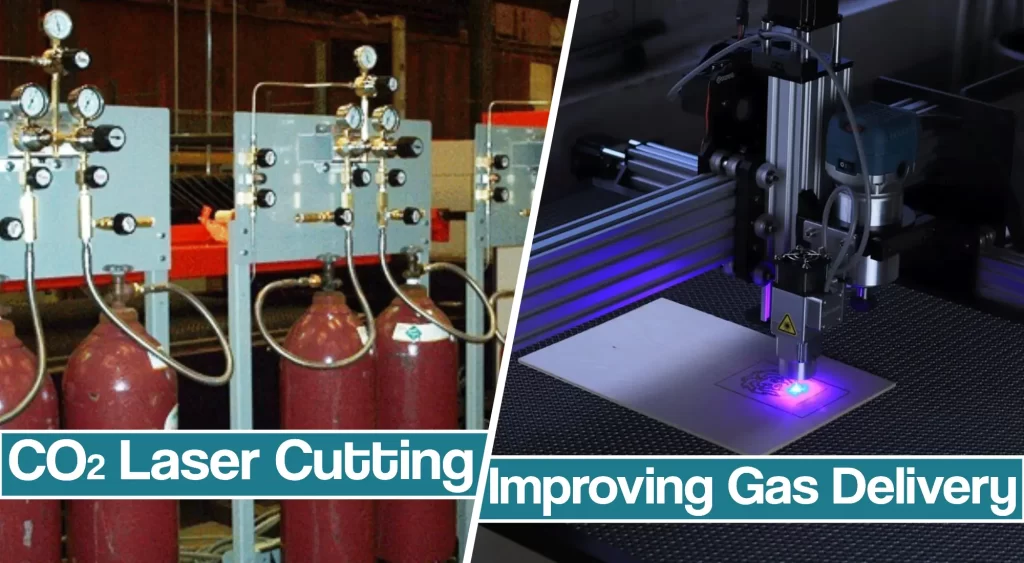
Thermal-cutting lasers are one of the most efficient means used today for cutting metal. With the high level of accuracy and repeatability, these systems can deliver, a laser quickly becomes the preferred tool for most metal fabricators.
There are several types of cutting lasers available: YAG, DISC, Fiber, Excimer and CO2: The focus here is on CO2 laser cutting gas delivery equipment requirements.
CO2 Laser Cutting Gas Delivery And Type Of Gases Used
CO2 lasers require several different types of gases to operate. The gas sources and delivery systems needed are not included with new machines and are rarely offered with used machines when resold.
The part of the laser that creates the cutting beam is called the resonator.
The gases required are high-purity grade 5 or better, CO2, Nitrogen, and Helium.
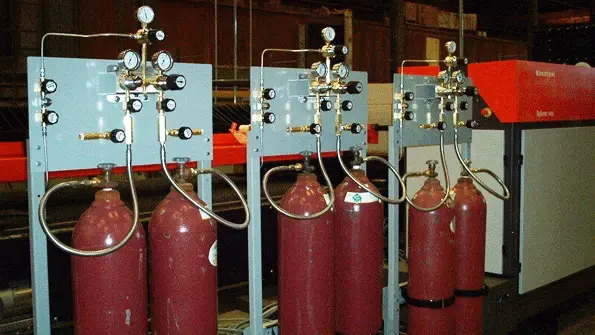
Sometimes carbon monoxide will be added into the resonator gas mix, depending on the resonator manufacturer. You can learn more about shielding gases used for welding and cutting in our linked article.
Inlet Purging Gases
Inlet purging of resonator gases when hooking up a new cylinder must be done to remove ambient air, moisture, and contamination prior to gas entering the resonator.
If moisture or particulate contamination enters the resonator chamber with the resonator gases, it will damage the resonator. The first symptoms that indicate this has happened are poor cut quality and high-power consumption by the laser.
Some laser manufacturers have developed resonators that use such small amounts of these gases that they come supplied with the machine and don’t require replacement for a year or more. High-purity two-stage regulators equipped with inlet purging capability are recommended.
Uninterrupted Source Of Gas For CO2 Lasers
If customers have invested in material-handling systems, they probably are intending to run the laser unattended and will require an uninterrupted source of gas.
If the laser is to run unattended, you will need a continuous supply of these gases, or the laser will turn itself off when the gas runs out.
Outfitting the laser with a high-purity gas switchover system equipped with inlet purges is the best way to keep this from happening.
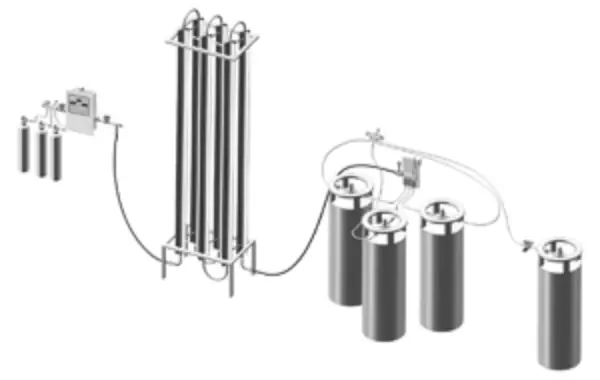
Normal operating pressure to the back of the laser ranges from 50-125 psi. Resonator gas consumption is low and it can take several months to empty a 200 or 300 cubic foot cylinder.
Other items often ignored when setting up resonator gas systems are relief valves to protect from a regulator failure, and in-line filters to ensure clean, non-contaminated gas.
Most laser manufacturers recommend using 2-micron inline filters and appropriate relief valves installed in the line between the outlet of the resonator gas switchover or regulator and the back of the laser.
Beam Purge Gas
The beam purge system is designed to provide a clean, dry atmosphere for the beam delivery optics in the resonator to direct and maintain beam quality to the workpiece.
Most laser manufacturers strongly recommend nitrogen as the beam-purge gas.
Normally, this can be drawn from the same nitrogen gas source as the assist gas being supplied. In some cases, the laser manufacturer will allow clean, dry air to be used for beam purging.
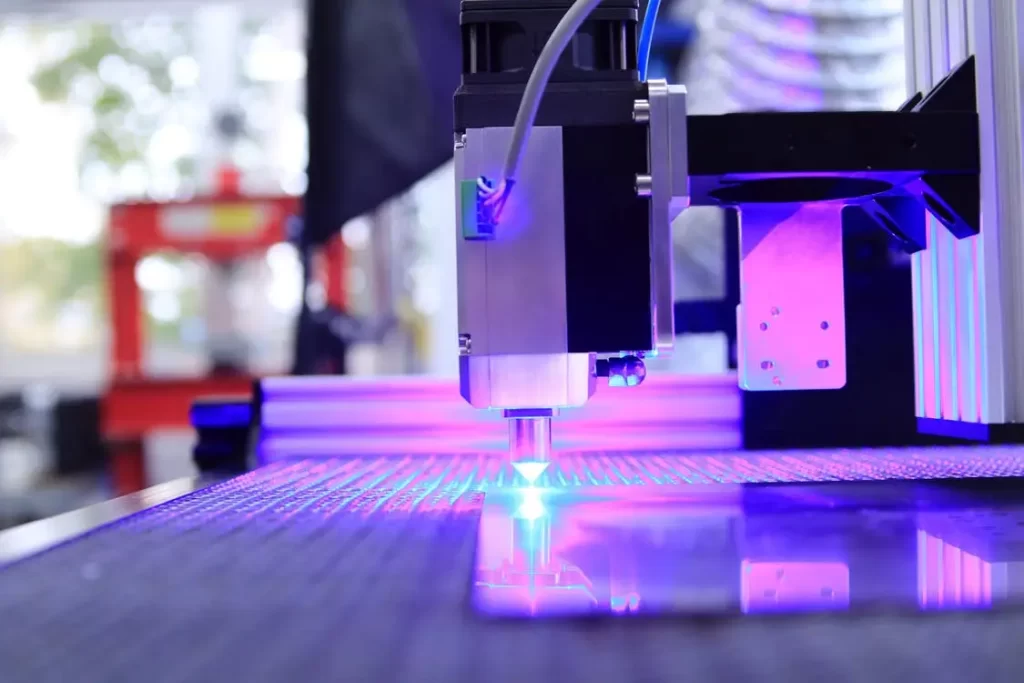
Operating pressures range from 50 to 100 psi and flow requirements range from 80 to 120 scfh. A high-purity single-stage regulator is the appropriate regulator recommendation for this function.
Assisting Gas Requirements
For the nitrogen and oxygen assist-gas requirements, high-pressure cylinder “cradles” can be used for a startup or low-flow applications, but these are inefficient and costly when the application demands higher flows.
Average nitrogen pressures required at the back of the laser range from 300 to 500 psi, and flow requirements can be in the 2,000- to the 4,000-scfh range. Oxygen pressures range from 200 to 400 psi, with flows between 500 and 1,500 scfh, depending on the material cut.
For assist-gas delivery, the recommended regulators are high-flow dome-loaded or balance-stem design. When setting up the nitrogen and oxygen assist-gas system, laser manufacturers recommend installing 40-micron inline filters and appropriately sized relief valves, too.
Because of the high-flow requirements for assist gas, the next step would be liquid cylinders for the economical continuous use of these gases.
Gas vs. Liquid Cylinders
Liquid cylinders are essentially big thermos bottles capable of delivering gas or liquid product to an application, and are commonly available in oxygen, nitrogen, argon, and CO2 service.
One liquid cylinder’s volume is equal to approximately 15 to 20 high-pressure cylinders, and it costs much less to fill one liquid cylinder than it does to fill 20 high-pressure cylinders.
Liquid cylinders have a gas-use port, liquid-use port, and vent-connection port on the top of the cylinder. A pressure-building circuit generates additional pressure and flow to the application and an economizer circuit to keep from generating gas when demand is low.
Safety relief valves set at 230, 350, or 500 psi are installed on the liquid cylinder to insure internal pressures will never reach the point where the cylinder could rupture or explode.
With standard liquid nitrogen and oxygen cylinders, the pressure-building capacity is normally around 300 scfh, with a peak flow of 350 scfh for short periods.
If the application demands more flow than one cylinder can provide, additional cylinders can be added to supply the application.
When choosing a switchover system, it is good to remember that pressure-differential switchovers do not work efficiently with liquid cylinders supplying the product.
If the demand for gas is too high for a liquid cylinder to keep up with, the head pressure in the cylinder will drop below the switchover point and create a false or premature empty condition.
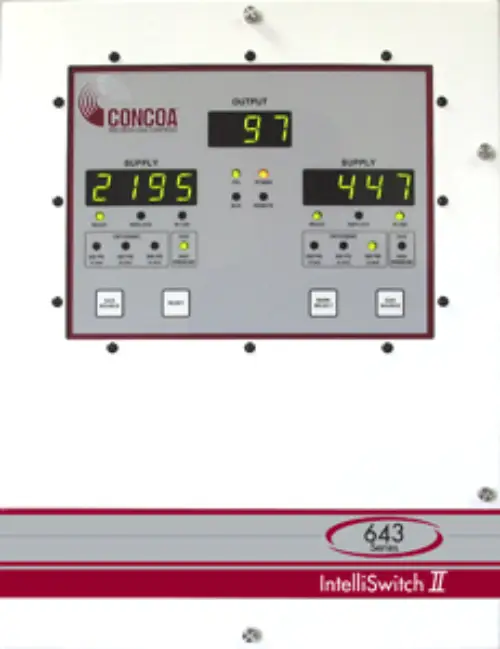
One solution is to extract the liquid product from the liquid cylinder and put it through an external vaporizer to create larger volumes of gas product. Multiple liquid cylinders can be connected to a cryogenic manifold to feed a continuous supply of liquid product to the vaporizers.
A pusher system can be used to ensure that the entire liquid product in a cylinder is used, and constant pressure and flow to the vaporizer and downstream application are maintained.
With a pusher system, the outlet pressure (gas) of a separate liquid cylinder (pusher) is used to force the liquid product out of the (slave) liquid cylinder(s) through the cryogenic manifold and into the vaporizer.
Then, an uninterrupted supply of gas can be provided to a laser assist-gas system by locating a pusher system on either side of a fully automatic switchover system.
With the pusher system, you are limited only by the vaporizer’s rated capacity to produce a gas product and the number of cylinders hooked up to supply the application.
No matter the gas delivery solution you prefer, it is important not to wait until the laser’s delivery day to decide what gas handling equipment will be purchased. It is important to review all the options available with your local gas distributor, and to allow enough time to source the correct system for the application.





